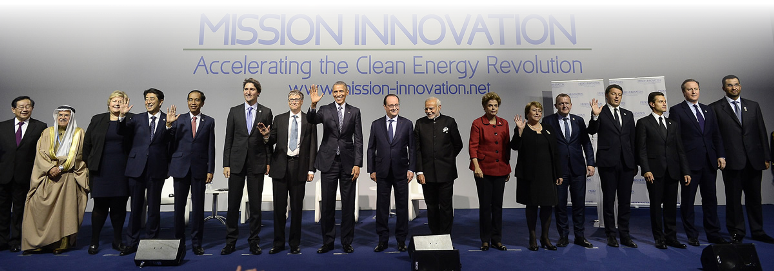
The world is making a dynamic shift to clean energy sources, with the Paris Agreement entering into force just a year following its adoption. Japan needs to quickly reprioritize its energy policy, asserts energy expert Hikaru Hiranuma, if it hopes to avoid being left out of a sweeping global trend.
* * *
The first conference of the parties to the Paris Agreement (CMA1) was held in Marrakech from November 15 to 18, 2016, in conjunction with COP22. That the climate change agreement was ratified by enough countries for it to come into force—and for its first meeting to be held—just a year after its adoption at COP21 is an indication of the seriousness with which countries around the world are addressing the issue of greenhouse gas emissions. While Japan, too, ratified the agreement in November, the decision was not in time for the country to join the inaugural meeting as a signatory; unlike the United States, China, India, and the European Union, therefore, it participated in CMA1 as an observer. The ratification delay suggests that Japan does not have a firm grasp of where global trends are headed and points to latent energy risks for the country.
The Significance of the Paris Agreement
While there is an element of uncertainty over the agreement’s future, given President-elect Donald Trump’s pledge to pull the United States out, the significance of the accord lies in its attempt to encourage all countries to shift the focus of their energy policies by promoting fossil fuel divestment; advancing the shift to wind, solar, geothermal, and other renewable sources; and enhancing energy efficiency.
One reflection of the enthusiasm countries brought to the task of mitigating global warming was the launch during COP21 of Mission Innovation, a global initiative of 22 countries and the European Union to accelerate clean energy innovation. The kickoff meeting in Paris was attended, among others, by US President Barack Obama, French President François Hollande, and Indian Prime Minister Narendra Modi, who pledged to double their public clean energy R&D investment over five years to achieve performance breakthroughs and cost reductions and provide widely affordable and reliable clean energy solutions. The 22 member countries represent 75% of the world’s carbon dioxide emissions and 80% of global clean energy investment, so their pledge to double their clean energy research is certain to have a big impact.
Mission Innovation will be working closely with the Breakthrough Energy Coalition, network of private investors, spearheaded by Microsoft founder Bill Gates, who are committed to accelerating the shift to clean energy by supporting the ideas that come out of the public research pipeline in the MI countries. This public-private partnership that emerged from the Paris Agreement is of unprecedented scale and holds the promise of fundamentally altering the course of the world’s energy trends through the commercialization and deployment of clean energy technologies.
A Huge Global Market
That said, Japan faces two significant risks. Aggressive clean energy investments by the Paris Agreement signatory countries will generate a burgeoning market; [1] Prime Minister Shinzo Abe’s “Japan Is Back” growth strategy anticipates the size of the global clean energy sector quadrupling from 40 trillion in 2013 to 160 trillion in 2030—placing it on a par with the global auto market. The speed with which the Paris Agreement was ratified by the world’s leading emitters is an indication of their desire to tap into this fast-growing market. Whether or not Japan can claim a sizable share of the pie will hinge on being able to position cleaner sources at the center of the country’s energy policy in line with global trends and nurturing a domestic clean energy sector to encourage the development of new technologies and services. Japan risks squandering business opportunities, though, through its wait-and-see attitude, as evidenced by the delay in ratifying the Paris accord.
Even a country that is as highly reliant on nuclear energy as France, the host of COP21, enacted the Energy Transition for Green Growth Act in 2015 calling for an increase in the percentage of renewable sources to 40% by 2030 and correspondingly lowering the share of nuclear power. The EU as a whole will seek to raise renewable’s share from 21% at present to at least 45% in 2030, accelerating the shift to clean energy and building a domestic market for new technologies and services. [2] Unless Japan, too, moves quickly to reprioritize its energy sources and embrace renewables, it risks being increasingly isolated from global trends and finding itself left out of the burgeoning clean energy market.
Competition for Rare Metals
Another risk for Japan involves access to rare earths, which are indispensable in many clean energy systems, including those for solar and wind, as well as in high-efficiency storage cells. Photovoltaic devices require silicon, selenium, indium, and gallium; wind power generation relies on such rare earths as neodymium and dysprosium; and lithium-ion batteries use lithium, cobalt, nickel, and manganese. Japan is one of the world’s biggest consumers of these materials, almost all of which it must import. In 2014 Japan led the world in the use of indium and gallium, was second in the consumption of selenium and rare earth elements, [3] third in nickel, fourth in cobalt and silicon, and fifth in manganese. [4] The shift to clean energy sources in the EU and elsewhere over the next decade or so suggests that global demand for these metals will rise, intensifying competition for their procurement. Japan, naturally, will confront the risk of losing access, but it does not appear to be taking any significant steps to guarantee continued shipment.
Beijing effectively imposed a ban on rare earth exports to Japan in September 2010 following a collision between a Chinese fishing trawler and a Japan Coast Guard patrol boat in waters near the Senkaku Islands, dealing a major blow to Japanese industry. Measures are needed to prevent a recurrence of such events, but there are limits to what individual countries can accomplish, inasmuch as the shift to clean energy is sweeping the globe. For the past few years, therefore, I have been advocating the creation of an international framework for the sustainable development and use of rare earth resources. Recent trends suggest that there is much greater need for such a scheme. Fossil fuels like coal, oil, and natural gas are regarded as common resources essential for the survival and prosperity of humankind; the International Energy Agency and other organizations exist to monitor resource trends and promote international cooperation, thereby helping to stabilize the supply and demand of these resources. A similar global body should be established for rare earths. In fact, precisely such a proposal was made at a lecture on November 9, 2015, at the AAAS Center for Science Diplomacy, delivered by American rare metals expert David S. Abraham, who advocated the creation of an International Materials Agency. [5] Momentum to establish such an organization should build as countries around the world turn to green technologies in fulfilling their Paris Agreement pledges.
Japan’s Outdated Energy Sector
Had Japan participated in CMA1 as a full party to the agreement, it could have been among the first to raise the issue of the rare-earth-related procurement risks mentioned above and even to propose the establishment of an International Materials Agency. The failure to move quickly, as exposed by the ratification delay, has cost the country a chance to raise its international presence in clean energy negotiations and to get a head start on building a home market in related technologies and services.
Embracing clean energy will entail a fundamental shift away from existing large-scale power generation centered on fossil fuels and nuclear power in lieu of more decentralized systems incorporating a variety of renewable sources. Clean energy is not a new concept, of course, having been promoted for years in a number of industrial countries, with many already having the necessary infrastructure in place to take the next bold step. Examples include the creation of open power transmission grids through the separation of electric power generation from transmission and distribution and the liberalization of the electricity market. Spain, which has been a pioneer in the shift to renewable sources, separated power generation and transmission operations as early as 1985, and fully liberalized the electricity market, including that for the household sector, in 2003. Germany liberalized its retail power market in 1998 and severed the generation-transmission link in 2009.
Japan’s energy sector remains largely unchanged from that fashioned after World War II, with regional power monopolies relying on centralized, large-scale power plants to meet demand. It was not until April 2016—five years following the Fukushima disaster—that electric utilities were deregulated; and power generation will not be split from transmission until 2020, a much later date than in the United States and many European countries. The timeline for these measures is an outgrowth of a mindset that seems oblivious to rapidly changing global trends. There is no turning back the clock, however, and Japan needs to make a bold shift in its energy policy without delay.
[1] While “clean energy” is yet without a clear definition, the June 14, 2013, cabinet decision on the Japan Is Back growth strategy cited renewable sources and high-efficiency energy systems and services. Specifically, it referred to renewables; high-efficiency thermal power generation; storage cells; next-generation devices and materials; energy-management systems; next-generation vehicles; fuel cells; and energy-saving appliances, homes, and buildings.
[2] Questions and Answers on 2030 Framework on Climate and Energy (January 22, 2014), http://europa.eu/rapid/press-release_MEMO-14-40_en.htm .
[3] On July 12, 2016, Daido Steel and Honda Motor announced that they had succeeded in developing the world’s first high-performance magnet containing no dysprosium or other heavy rare earth elements. The development of the magnet, to be used in the motor of hybrid vehicles, may henceforth reduce demand for such elements, https://www.tkfd.or.jp/en/research/detail.php?id=448 .
[4] Report on the stockpiling of rare metals by country issued by the Japan Oil, Gas and Metals National Corporation (JOGMEC), March 2016.
[5] Abraham also makes this point in The Elements of Power: Gadgets, Guns, and the Struggle for a Sustainable Future in the Rare Metal Age , published by Yale University Press in October 2015.


